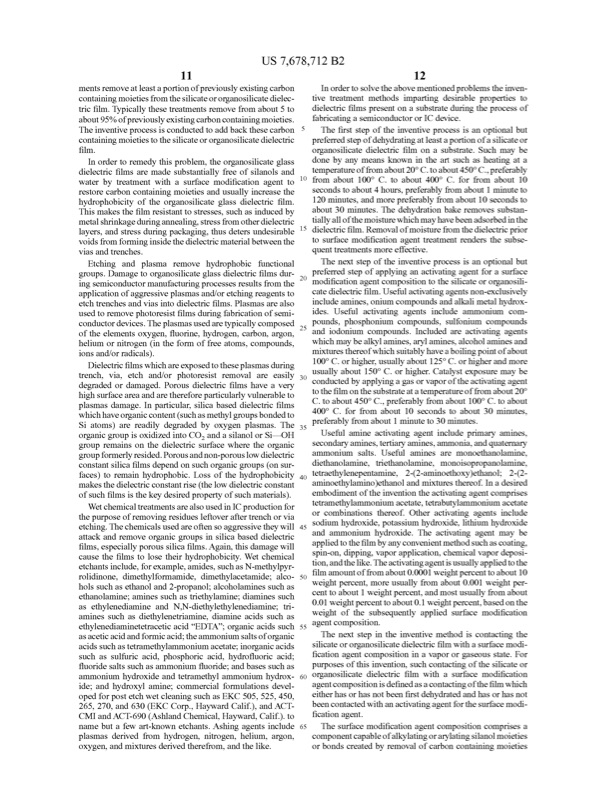
PDF Publication Title:
Text from PDF Page: 012
11 mentsremoveatleastaportionofpreviouslyexistingcarbon containingmoietiesfromthesilicateororganosilicatedielec tricfilm.Typicallythesetreatmentsremovefromabout5to about95%ofpreviouslyexistingcarboncontainingmoieties. Theinventiveprocessisconductedtoaddbackthesecarbon containingmoietiestothesilicateororganosilicatedielectric film. Inordertoremedythisproblem,theorganosilicateglas dielectricfilmsaremadesubstantialyfreofsilanolsand waterbytreatmentwithasurfacemodificationagentto10 restorecarboncontainingmoietiesandusualyincreasethe hydrophobicityoftheorganosilicateglasdielectricfilm. Thismakesthefilmresistanttostreses,suchasinducedby metalshrinkageduringannealing,stresfromotherdielectric layers,andstresduringpackaging,thusdetersundesirable15 voidsfromforminginsidethedielectricmaterialbetweenthe viasandtrenches. Etching and plasma remove hydrophobic functional groups.Damagetoorganosilicateglasdielectricfilmsdur ingsemiconductormanufacturingprocessesresultsfromthe aplicationofaggressiveplasmasand/oretchingreagentsto etchtrenchesandviasintodielectricfilms.Plasmasarealso usedtoremovephotoresistfilmsduringfabricationofsemi conductordevices.Theplasmasusedaretypicalycomposed25 oftheelementsoxygen,fluorine,hydrogen,carbon,argon, heliumornitrogen(intheformoffreatoms,compounds, ionsand/orradicals). 12 Inordertosolvetheabovementionedproblemstheinven tivetreatmentmethodsimpartingdesirablepropertiesto dielectricfilmspresentonaSubstrateduringtheprocessof fabricatingasemiconductororICdevice. Thefirststepoftheinventiveprocessisanoptionalbut preferedstepofdehydratingatleastaportionofasilicateor organosilicatedielectricfilmonaSubstrate.Suchmaybe donebyanymeansknownintheartSuchasheatingata temperatureoffromabout20°C.toabout450°C.,preferably fromabout100°C.toabout400°C.forfromabout10 secondstoabout4hours,preferablyfromabout1minuteto 120minutes,andmorepreferablyfromabout10secondsto about30minutes.Thedehydrationbakeremovessubstan tialyalofthemoisturewhichmayhavebeenadsorbedinthe dielectricfilm.Removalofmoisturefromthedielectricprior toSurfacemodificationagenttreatmentrenderstheSubse quenttreatmentsmoreefective. Thenextstepoftheinventiveprocessisanoptionalbut preferedstepofapplyinganactivatingagentforaSurface modificationagentcompositiontothesilicateororganosili catedielectricfilm.Usefulactivatingagentsnon-exclusively includeamines,oniumcompoundsandalkalimetalhydrox ides.Usefulactivatingagentsincludeammonium com pounds,phosphoniumcompounds,Sulfoniumcompounds andiodoniumcompounds.Includedareactivatingagents whichmaybealkylamines,arylamines,alcoholaminesand mixturesthereofwhichsuitablyhaveaboilingpointofabout US 7,678,712B2 Dielectricfilmswhichareexposedtotheseplasmasduring 100°C.orhigher,usualyabout125°C.orhigherandmore trench,via,etchand/orphotoresistremovalareeasily30 degradedordamaged.Porousdielectricfilmshaveavery highsurfaceareaandarethereforeparticularlyvulnerableto plasmasdamage.Inparticular,silicabaseddielectricfilms whichhaveorganiccontent(suchasmethylgroupsbondedto Siatoms)arereadilydegradedbyoxygenplasmas.The35 organicgroupisoxidizedintoCO andasilanolorSi-OH groupremainsonthedielectricSurfacewheretheorganic groupformerlyresided.Porousandnon-porouslowdielectric constantsilicafilmsdependonSuchorganicgroups(onSur faces)toremainhydrophobic.Lossofthehydrophobicity40 makesthedielectricconstantrise(thelowdielectricconstant ofsuchfilmsisthekeydesiredpropertyofsuchmaterials). WetchemicaltreatmentsarealsousedinICproductionfor thepurposeofremovingresiduesleftoveraftertrenchorvia etching.Thechemicalsusedareoftensoaggressivetheywil45 atackandremoveorganicgroupsinsilicabaseddielectric films,especialyporoussilicafilms.Again,thisdamagewil causethefilmstolosetheirhydrophobicity.Wetchemical etchantsinclude,forexample,amides,suchasN-methylpyr rolidinone,dimethylformamide,dimethylacetamide:alco50 holssuchasethanoland2-propanol;alcoholaminessuchas ethanolamine;aminessuchastriethylamine;diaminesSuch asethylenediamineandN,N-diethylethylenediamine;tri aminessuchasdiethylenetriamine,diamineacidssuchas ethylenediaminetetraceticacid“EDTA';organicacidssuch55 asaceticacidandformicacid;theammoniumsaltsoforganic acidssuchastetramethylammoniumacetate;inorganicacids SuchasSulfuricacid,phosphoricacid,hydrofluoricacid; fluoridesaltssuchasammoniumfluoride;andbasessuchas ammoniumhydroxideandtetramethylammoniumhydrox60 ide;andhydroxylamine;commercialformulationsdevel opedforpostetchwetcleaningsuchasEKC505,525,450, 265,270,and630(EKCCorp.,HaywardCalif.),andACT CMIandACT-690(AshlandChemical,Hayward,Calif.).to namebutafewart-knownetchants.Ashingagentsinclude 65 plasmasderivedfromhydrogen,nitrogen,helium,argon, oxygen,andmixturesderivedtherefrom,andthelike. usuallyabout150°C.orhigher.Catalystexposuremaybe conductedbyapplyingagasorvaporoftheactivatingagent tothefilmonthesubstrateatatemperatureoffromabout20° C.toabout450°C.,preferablyfromabout100°C.toabout 400°C.forfromabout10secondstoabout30minutes, preferablyfromabout1minuteto30minutes. Usefulamineactivatingagentincludeprimaryamines, secondaryamines,tertiaryamines,ammonia,andquaternary ammonium salts. Useful amines are monoethanolamine, diethanolamine, triethanolamine, monoisopropanolamine, tetraethylenepentamine, 2-(2-aminoethoxy)ethanol: 2-(2- aminoethylamino)ethanolandmixturesthereof.Inadesired embodimentoftheinventiontheactivatingagentcomprises tetramethylammoniumacetate,tetrabutylammoniumacetate orcombinationsthereof.Otheractivatingagentsinclude Sodiumhydroxide,potassiumhydroxide,lithiumhydroxide andammoniumhydroxide.Theactivatingagentmaybe appliedtothefilmbyanyconvenientmethodsuchascoating, spin-on,diping,vaporaplication,chemicalvapordeposi tion,andthelike.Theactivatingagentisusualyappliedtothe filmamountoffromabout0.0001weightpercenttoabout10 weightpercent,moreusualyfromabout0.001weightper centtoabout1weightpercent,andmostusualyfromabout 0.01weightpercenttoabout0.1weightpercent,basedonthe weightoftheSubsequentlyappliedSurfacemodification agentcomposition. Thenextstepintheinventivemethodiscontactingthe silicateororganosilicatedielectricfilmwithasurfacemodi ficationagentcompositioninavapororgaseousstate.For purposesofthisinvention,suchcontactingofthesilicateor organosilicatedielectricfilmwithasurfacemodification agentcompositionisdefinedasacontactingofthefilmwhich eitherhasorhasnotbeenfirstdehydratedandhasorhasnot beencontactedwithanactivatingagentfortheSurfacemodi ficationagent. TheSurfacemodificationagentcompositioncomprisesa componentcapableofalkylatingorarylatingsilanolmoieties orbondscreatedbyremovalofcarboncontainingmoietiesPDF Image | VAPOR PHASE TREATMENT OF DELECTRIC MATERALS

PDF Search Title:
VAPOR PHASE TREATMENT OF DELECTRIC MATERALSOriginal File Name Searched:
US7678712.pdfDIY PDF Search: Google It | Yahoo | Bing
Sulfur Deposition on Carbon Nanofibers using Supercritical CO2 Sulfur Deposition on Carbon Nanofibers using Supercritical CO2. Gamma sulfur also known as mother of pearl sulfur and nacreous sulfur... More Info
CO2 Organic Rankine Cycle Experimenter Platform The supercritical CO2 phase change system is both a heat pump and organic rankine cycle which can be used for those purposes and as a supercritical extractor for advanced subcritical and supercritical extraction technology. Uses include producing nanoparticles, precious metal CO2 extraction, lithium battery recycling, and other applications... More Info
| CONTACT TEL: 608-238-6001 Email: greg@infinityturbine.com | RSS | AMP |